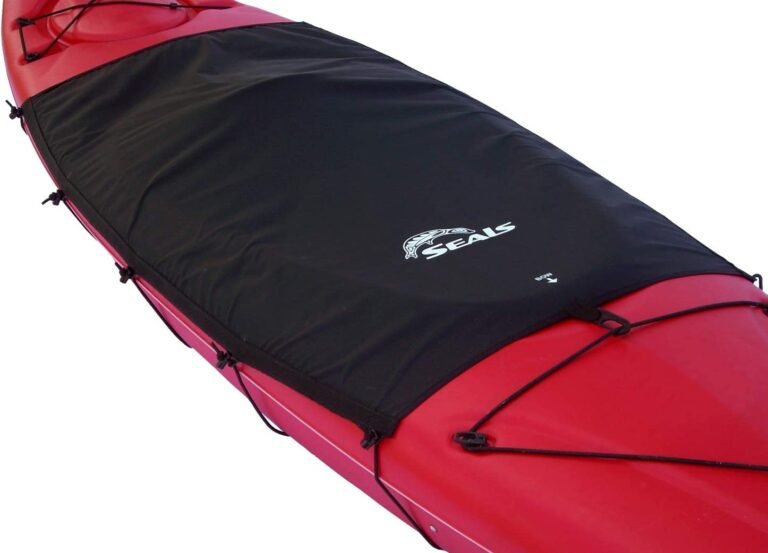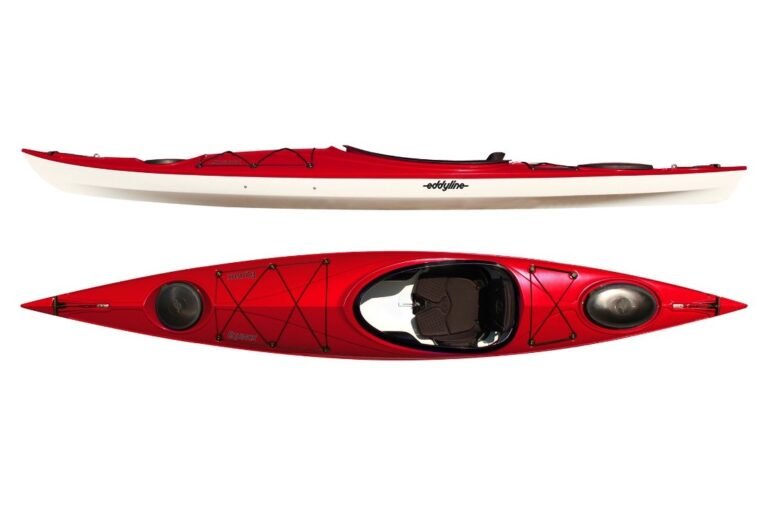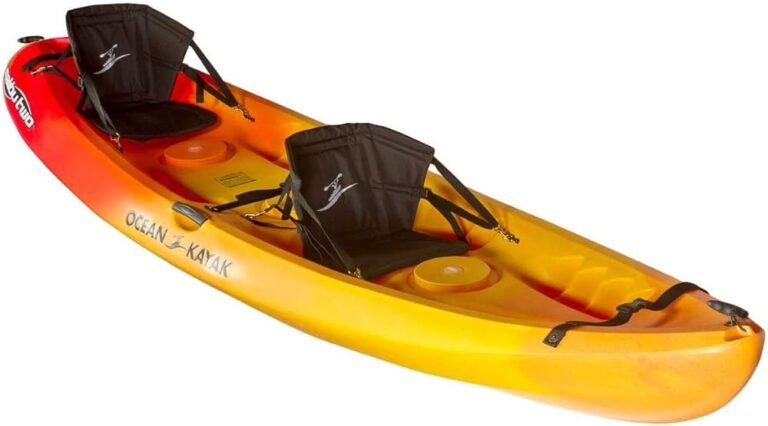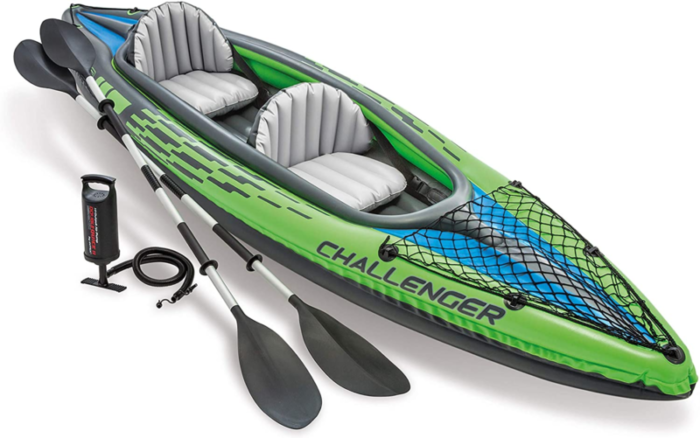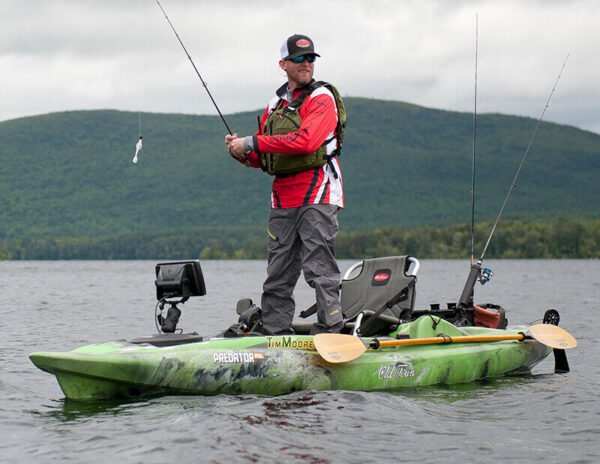Canoe Vs Kayak: What Are The Differences?

Watersports grow more popular every day with paddle sports at the wheel. Two of the most popular paddle sports are kayaking and canoeing, sports which involve navigating a watercraft through water with the use of a single-bladed or double-bladed paddle.
Though these two sports may seem similar, they are very different and part of that difference comes from the watercraft inherent to each sport.
Kayaking makes use of kayaks while canoeing makes use of canoes. As you get more familiar with watersports, being able to tell different watercraft apart becomes essential as you never can tell when you will need to make use of one.
Knowing the differences between kayaks and canoes will also give you better insight into each sport and allow you to enjoy either or both of them better. In this article, we dive into what makes kayaks and canoes different from each other.
What Is A Kayak?
A kayak is a type of watercraft that is used for navigation and recreation. It is similar in shape to a canoe, but with an improved design that allows it to be navigated much more easily in water.
Kayaks are propelled with the use of a paddle that could be single-bladed or double-bladed. They can be either solo (for one paddler) or tandem (for two paddlers) kayaks. Kayaks are typically made from plastic or fiberglass and can be stored easily in a small space.
They are great for exploring rivers and lakes, as well as taking short trips down the coast. They can be used for a variety of purposes including fishing, touring, and exploring. Kayaks are also versatile enough to be used on inland waterways or the ocean.
Kayaks are typically versatile enough to handle a variety of water conditions, from calm lakes to challenging rapids making them perfect for people seeking a range of water conditions to exercise in.
What Is A Canoe?
A canoe is a light, long, and narrow watercraft with pointed ends and no keel. Canoes are non-motorized and are instead propelled by humans with the use of single-bladed paddles.
Canoes are one of the oldest forms of water transportation having been used for thousands of years and are still in use today. Canoes can be made from a variety of materials including wood, plastic, and fiberglass and they vary in shape and size.
Canoes like kayaks are designed to be used in a variety of paddling conditions from calm beautiful waters to rough or choppy currents. Canoes are used for various purposes including fishing, paddling, and touring.
Advantages Of Canoes
1. They Are Typically Lighter Than Kayaks.
Though not always, canoes are often lighter than kayaks of the same size. This is a significant advantage as it means carrying canoes is usually easier than carrying kayaks.
This advantage comes into play when you have to portage the watercraft or load it onto a vehicle or storage rack. Since canoes don’t weigh as much, they can be carried with minimal effort and less stress.
The reason why canoes are often lighter is that the tops of these watercraft are open, unlike kayaks that make use of decks.
The result of this is that a large canoe usually weighs the same as a smaller kayak with tandem canoes usually weighing the same or less than solo touring kayaks made of the same material.
Whenever considering canoes and kayaks, remember that canoes often weigh less and are thus easier to portage.
2. Canoes Have More Cargo Capacity Than Similarly Sized Kayaks.
The very design of canoes (their lack of decks) makes them have more storage capacity than kayaks. It also makes them easier to load and unload.
This advantage makes canoes the preferred watercraft when you intend to carry a lot of gear and/or people. Since kayaks have decks, they require hatches for storing gear making them unsuitable for those with a lot of gear.
The nature of kayaks also makes carrying more people than the vessel is designed for dangerous.
3. Canoes Are Easier To Portage Than Kayaks.
As canoes are often lighter than kayaks, they are also easier to portage. Portaging is important as most popular canoe routes involve portaging which means carrying your canoe from one water body to the other.
A canoe can be easily fitted with a portaging yoke which allows a single person to move them along the portage trail and be on his merry way. Kayaks are more difficult to portage making canoes superior to them in that aspect.
Disadvantages Of Canoes
1. Canoes Are Harder To Control In Winds Than Kayaks.
While their lack of decks makes them lighter and easier to portage than kayaks, it also makes them harder to paddle in windy conditions as their open design catches more wind and creates more drag than kayaks.
Another factor contributing to this difficulty in navigation is the fact that canoes are deeper than kayaks resulting in the paddlers sitting higher in the watercraft than they would in kayaks.
The result of all these is that canoes are less stable and thus more difficult to control than kayaks in windy conditions.
2. They Are More Susceptible To Large Waves Than Kayaks.
Again, the lack of decks on canoes works against them. Should the canoeist encounter large waves while paddling, they can easily splash into the canoe filling it with water which could lead to the vessel sinking.
To deal with this problem, many canoes (especially whitewater canoes) fill the watercraft with large airbags but it is an undeniable fact that the decks on kayaks do a better job of keeping water out of the watercraft. Kayaks generally handle waves better than canoes.
3. Canoes Require More Stroke Knowledge Than Kayaks.
To properly navigate your canoe, you have to know a few extra paddling strokes peculiar to canoeing than you would need when kayaking.
While learning these strokes is not difficult, they take time to master. Beginners might find it easier to go into kayaking which would take less time to learn so they can enjoy the beauty of nature as quickly as possible.
Advantages Of Kayaks
1. Kayaks Are Easier To Control In Windy Conditions.
The presence of decks, the fact that kayaks are more shallow than canoes and that the paddler sits closer to the water all combine to make kayaks more stable than their cousins in windy conditions.
This is because kayaks catch less wind and have less drag than canoes leaving them more in control of the paddler when the winds get out of control. This significant advantage means that kayaks are preferable when navigating windy areas.
2. Kayaks Are Easier To Navigate Than Canoes.
As kayaks use double-bladed paddles, it makes it significantly easier to keep them moving in an intended direction than canoes. Some kayaks are even fitted with rudders to further ease this task making kayaks easier to control than canoes.
3. Kayaks Handle Waves Better Than Canoes.
As canoes lack decks, water can easily enter the vessels when they encounter large waves. Kayaks on the other hand have decks that help keep water out of the watercraft.
Kayaks’ cockpits can also be easily fitted with spray skirts to help keep out the water that gets beyond the deck, an advantage that canoes lack.
The result of this is that a skilled kayaker can navigate tricky conditions while still avoiding swamping and a kayaker can right his watercraft after a capsize without water entering his cockpit. Kayaks simply are better equipped to handle waves than canoes.
Disadvantages Of Kayaks
1. Kayaks Are Typically Heavier Than Canoes.
To provide more stability and comfort, kayaks are fitted with decks, hatches, comfortable seats, and bulkheads. The downside to the addition of these things is that they significantly increase the kayak’s weight.
The result is that even small recreational kayaks are heavier than some canoes making them harder or impossible (for some) to lift to the roof of a vehicle for transport much less portage over long distances.
Fortunately, the use of special materials allows for light kayaks to be built these days so that even though canoes built of the same materials are lighter, the kayaks are easier to portage.
The important thing to note however is that on average, a kayak will always be heavier than a canoe.
2. Kayaks Have Less Storage Capacity Than Canoes.
The presence of a deck on kayaks drastically reduces the cargo capacity of kayaks making canoes the preferable option where a lot of loads are involved.
The nature of kayaks also makes them harder to load with cargo as bags must be loaded into a kayak one at a time until the storage compartments are full. That nature also makes offloading kayaks also harder than canoes.
If you are adventuring in an area where you have to portage a lot or intend to pack a lot of gear, canoes will make the task easier for you.
Differences Between Kayaks and Canoes
Before choosing one of these vessels, it is crucial to know the differences between them to make an informed decision. The differences between kayaks and canoes are given below.
Speed
One interesting difference between these two watercraft is that kayaks are faster than canoes. This is due to the design of both watercraft.
As kayaks are fitted with decks, they are less prone to wind resistance and drag enabling them to move easily and thus faster through the water than their single-bladed paddled cousins.
Another reason why kayaks are faster than canoes is that they are more stable than the latter and have their paddlers sitting closer to the water than canoes.
This makes it easier for kayakers to paddle their vessel and makes them move faster.
Seats
The seats on kayaks are more comfortable than those on canoes. Recreational and fishing kayaks in particular usually have elaborate, highly adjustable seats with tall backrests.
In contrast, canoe seats are quite basic. A classic canoe seat is a flat bench covered with a cane or nylon webbing. This seat style allows canoeists to sit or kneel as they paddle their watercraft.
While not all kayak seats are as elaborate as those found on recreational and fishing kayaks, they are quite comfortable. This implies that paddling for a long time in a kayak will most likely be more pleasurable.
It is also important to note that the seating position of paddlers in kayaks is closer to the water than the seating position of paddlers in canoes. This also helps in making kayaks faster as their paddles connect with the water with minimal effort.
Maneuverability
Kayaks are the more maneuverable of the two watercraft. The fact that kayaks are paddled with double-bladed paddles and that they handle windy conditions and choppy waters better make them more maneuverable than canoes thus making them better for navigating dangerous waters.
Paddles
Another way to differentiate between kayaks and canoes is by the paddles they use. A kayak paddle is usually double-bladed that is it has a blade at each end.
The paddle is held with two hands and used to alternate strokes on each side of the vessel. Canoe paddles are instead single-bladed with a grip on the opposite end of the shaft.
While paddling the top hand holds the grip while the other hand holds the shaft near the blade. Whichever vessel you choose, it is a smart idea to invest in a quality paddle that will be light while being easier to use.
You will be thankful for your decision after spending the whole day paddling on the water.
Weight
Kayaks are usually heavier than canoes. This is because kayaks are outfitted with decks, bulkheads, hatches, seats, and other equipment. As canoes are lighter, they are thus easier to lift alone or portage across water bodies.
Storage Capacity
A major difference between kayaks and canoes is their storage space. Canoes are not only easier to load and offload than kayaks, but they also have more storage room than kayaks making them the preferred watercraft when the paddler wants to bring friends, children, or a lot of gear on the trip.
Cost
Canoes are typically more expensive than kayaks. This is because canoe production is difficult with only the use of machinery.
Even canoes that can be mass-produced require special care and adherence to design resulting in them being more expensive than kayaks. Beginner paddlers may thus prefer to purchase a kayak based on affordability alone.
Kayak Vs Canoe Stability
The issue of which of these paddle-propelled watercraft is more stable has been the issue of debate for a long time with some giving the title to canoes and others to kayaks. In reality, while they are both stable in water, kayaks are more stable because:
1. They have decks. The decks on kayaks protect the paddler from the waves and make them easier to control when the waves are unruly than canoes.
Also, as canoes lack decks they easily catch more wind and have more drag in windy conditions than kayaks making them harder to control in those conditions.
Since kayaks handle both the winds and waves better than canoes, this makes kayaks more stable than canoes.
2. Kayaks are shallower than canoes and the kayaker sits closer to the water. Another thing that makes kayaks more stable than canoes is inherent to their design.
Kayaks are typically shallower than canoes and as such, the kayaker’s seating position is closer to the water making it easier for him to control his vessel and promoting stability.
In contrast, canoes are deeper and the paddler sits further up from the water. This arrangement is decidedly less stable than the kayak’s setting and makes it more difficult to control canoes thus making kayaks the more stable of the two watercrafts.
Solo Canoe Vs Kayak
You may have to choose one of these watercraft someday. Kayaks offer comfortable seating, better stability, and maneuverability but fall short when it comes to storage space.
Canoes on the other hand are less stable than kayaks but are lighter and have more storage. That canoes weigh less is to their advantage as they would be easier to lift onto a vehicle and also easier to portage.
There is also the fact that if the vessel is intended for fishing, kayaks are more preferred than canoes. Which solo watercraft you purchase should be based on these criteria and your budget.
If the weight of the kayak does not border you you can go for it but if you want more cargo space and a lightweight watercraft, then you should pick a canoe.
Tandem Kayak Vs Canoe
Another thing to consider when stacking kayaks and canoes against each other is which of these watercraft is better for two paddlers; tandem kayaks or tandem canoes.
Statistics show that most kayaks purchased are solo kayaks while most canoes purchased are tandem canoes but that is not enough to give either canoes or kayaks the edge when it comes to an outing for two paddlers.
To make a comparison, all the advantages and disadvantages of kayaks and canoes have to be weighed. Kayaks have better stability and control in windy conditions and choppy water than canoes do.
Canoes make up for this by having more cargo capacity than kayaks to enable paddlers to bring as much gear as they want, children, and even pets.
Canoes are lighter than kayaks but this doesn’t help them much as two paddlers will be more than enough to easily lift the kayak onto a vehicle or portage the kayak. This leaves these two watercraft at something of a tie in deciding which is better for two paddlers.
The tie-breaker is a con of tandem kayaks. The bow and stern paddlers of tandem kayaks have to coordinate their paddle strokes so their paddles don’t crash into each other every so often.
Some tandem kayaks address this problem by having more space between the two cockpits but most tandem kayaks still face this problem.
In contrast, the roomy nature of canoes ensures tandem canoeists sit far apart and have no need to coordinate their strokes making for easier paddling.
This tie-breaker makes canoes to be preferred for tandem paddling especially when the paddlers intend to bring much gear, children, or pets.
It’s crucial to keep in mind that which vessel is better for each set of paddlers comes down to personal preference.
Canoe Vs Fishing Kayak
One activity canoeists and kayakers both take part in is fishing. It thus comes as no surprise that the question of which of these watercraft is better for fishing comes to mind.
The answer to this question depends primarily on where you are fishing. If you are paddling in an area where you will have to portage the watercraft periodically, a canoe is probably the best option for you as they are easier to portage since they weigh less than kayaks.
In the same vein, if you want to fish in a remote lake and have to hike first, a canoe is the best option for you as it will make the trip easier. You might want to pick a canoe too if you are going tandem fishing.
This is primarily due to the roomy nature of canoes and the fact that there is usually more space between tandem canoe paddlers than their tandem kayak counterparts.
The lack of need to synchronize your paddling strokes is another plus making canoes more suitable for tandem fishing.
Despite all these arguments for fishing in canoes, most people prefer fishing in kayaks, especially when paddling solo. It is thus no wonder that sit-on-top fishing kayaks in particular are quite popular among anglers.
These vessels are perfect for fishing as they are often wide enough to stand in and sometimes feature pedal foot drives which ensure your hands are free for casting your line.
Sit-on-top kayaks are typically heavy though especially if they are large enough to stand in so some anglers simply use more traditional recreational kayaks outfitted with fishing accessories like rod holders to catch fish.
Given that more people fish with kayaks than canoes, surely there is something about the watercraft that sets the mood for fishing.
Olympic Canoe Vs Kayak
Canoeing is a sport that combines speed, agility, and strength. It is popular in various parts of the world, including North America, Europe, and Asia.
Kayaking is the sister sport to canoeing. Kayakers use a double-bladed paddle to move their vessels in the water.
Canoes and kayaks designed for the Olympics are the best of each watercraft type available at the moment and will most likely be too expensive for the average kayaker.
If you have to choose between these vessels, however, your budget, personal preference, where you intend to use the vessel, and the pros and cons of each watercraft should help you make the appropriate choice.
Canoe Slalom Vs Kayak Slalom
Kayak slalom and canoe slalom are two different versions of the same sport. In kayak slalom, athletes race down a course while navigating around obstacles in a narrow channel.
In the canoe slalom, athletes navigate a course through a series of tight corners and curves. The two sports are very similar, but some key differences can affect the outcome of the race.
Canoe slalom is more physically demanding because athletes have to use more energy to keep their balance in the narrow channel.
Again which vessel is better for these sports? Before choosing to either kayak slalom or canoe slalom, remember the advantages and disadvantages of each of these watercraft.
The sport involves racing in the water while navigating obstacles so based on stability, speed, and maneuverability, kayaks are preferred for the sport.
You should however keep in mind that the race is either between kayaks or canoes so there is nothing wrong with being a fan and taking part in both versions of the sport.
Canoe Vs Kayak For Family
Canoeing and kayaking are great ways to spend a day on the river with your family. They offer different experiences, but both can provide plenty of fun for all.
Choosing between a canoe and a kayak for family recreation can be a difficult decision. Both vessels offer different advantages and disadvantages that should be considered before making a purchase.
Here are some key factors to consider:
- Pros and Cons of each watercraft.
- Which one is better for the family?
- The family’s budget.
The answer to the above is what will ultimately help you decide which of the vessels is better suited to your family. By now you know that kayaks are more stable and maneuverable while canoes have more storage space.
You also know that most tandem kayaks require coordination while paddling to prevent the paddles from hitting each other from time to time so you should be able to make a choice.
If you fancy kayaks, getting one or more tandem kayaks depending on how large the family is may appeal to you. The synchronicity required for paddling will not be a problem particularly if most family members are of an age to properly handle themselves on the water.
If you fancy canoes, however, they may be the better choice. They are roomier than kayaks and this helps when bringing much gear or if the family has little children you want to bring along on your trip. The elimination of the need for paddling synchronicity is also a bonus.
Before making a choice, you should weigh the pros and cons of each vessel, consider your preference, and also consider your budget. Canoes are most often chosen for family use though.
Canoe vs kayak vs rowboat
Kayaks, canoes, and rowboats are all types of watercraft that use different methods to move a person or object through water. Kayaks are typically the smallest of the three, while canoes are larger than kayaks but slower moving.
Rowboats are the largest and most versatile type of boat, capable of traveling at a faster speed than either canoes or kayaks but also being able to carry more people and cargo.
Kayaks and canoes also make use of paddles that let you face the direction you are heading while rowboats make use of oars that have you facing backward of the vessel’s direction.
Rowing also gives more exercise than paddling as leg muscles are involved in moving the watercraft. If you wish to try the three vessels, it is advisable to start with kayaks then move to canoes, and finally, make use of rowboats.
This order not only denotes the sports from easiest to hardest, but it also denotes the watercraft from cheapest to most expensive.
Kayak Vs Canoe Vs Raft
Kayaks, canoes, and rafts are three different types of watercraft that each have a sport of their own. Kayaks can typically carry up to two people for the sport while canoes with their roomy nature can carry more.
A raft can however carry up to 10 people. Kayaks, canoes, and rafts are used in kayaking, canoeing, and rafting respectively, sports that involve propelling a watercraft through water with the use of paddles.
After gaining paddling experience on a kayak and/or canoe, you can decide to engage in rafting, a group water sport performed on an inflatable raft with up to nine people paddling at a time (four on each side and one at the back) with single-bladed paddles.
Unlike kayaking and canoeing, rafting can only be done in rough waters, and the raft is completely open. Also, since rafting is a group sport, you may enjoy it more if you enjoy doing things in a group.
If not rafting might not be for you. Watersports are generally fun so you should give rafting a chance before deciding against it. Canoes and kayaks are both great ways to enjoy the water, but there are some differences between the two.
Canoes are typically wider and slower, making them better for calm waters or fishing. Kayaks are narrower and faster, making them better for rougher waters or navigating rapids.
Kayaks are more stable and maneuverable than canoes, while canoes have more storage space than kayaks. Canoes are also more expensive than kayaks.
Ultimately, the decision between a canoe or kayak comes down to personal preference, budget, and what you plan to use it for. Remember to always employ safe practices on the water.


